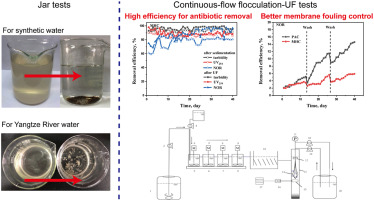当前位置:
X-MOL 学术
›
Water Res.
›
论文详情
Our official English website, www.x-mol.net, welcomes your feedback! (Note: you will need to create a separate account there.)
Role of moderately hydrophobic chitosan flocculants in the removal of trace antibiotics from water and membrane fouling control.
Water Research ( IF 12.8 ) Pub Date : 2020-04-05 , DOI: 10.1016/j.watres.2020.115775 Zhen Yang 1 , Tianyang Hou 1 , Jiangya Ma 2 , Bo Yuan 3 , Ziqi Tian 4 , Weiben Yang 1 , Nigel J D Graham 5
Water Research ( IF 12.8 ) Pub Date : 2020-04-05 , DOI: 10.1016/j.watres.2020.115775 Zhen Yang 1 , Tianyang Hou 1 , Jiangya Ma 2 , Bo Yuan 3 , Ziqi Tian 4 , Weiben Yang 1 , Nigel J D Graham 5
Affiliation

|
In this paper we describe the preparation and testing of a new class of chitosan-based flocculants for the treatment of surface waters containing antibiotic compounds. Three forms of moderately hydrophobic chitosan flocculants (MHCs) were prepared by chemically grafting hydrophobic branches with different lengths onto hydrophilic chitosan and these were evaluated by jar tests and a bench-scale continuous flow ultrafiltration (UF) membrane process with coagulation/sedimentation pre-treatment. Tests were conducted using both synthetic and real surface water in which norfloxacin and tylosin were added as representative antibiotics at an initial concentration of 0.1 μg/L. In jar tests, the MHCs achieved similar high removal efficiencies (REs) of turbidity and UV254 absorbance, but much higher REs of the two antibiotics (71.7-84.7% and 68.7-76.6% for synthetic and river waters, respectively), compared to several commercial flocculants; the superior performance was attributed to an enhanced hydrophobic interaction and H-bonding between the flocculants and antibiotics. The presence of suspended kaolin particles and humic acid enhanced the antibiotic removal, speculated to be through MHC bridging of the kaolin/humic acid and antibiotic molecules. In the continuous flow tests involving flocculation/sedimentation-UF for 40 days, an optimal MHC achieved a much greater performance than polyaluminium chloride in terms of the overall removal of antibiotics (RE (norfloxacin) of ∼90% and RE (tylosin) of ∼80%) and a greatly reduced rate of membrane fouling; the latter resulting from a more porous and looser structure of cake layer, caused by a surface-modification-like effect of residual MHC on the hydrophobic PVDF membrane. The results of this study have shown that MHCs offer a significant advance over the use of existing flocculants for the treatment of surface water.
中文翻译:

中度疏水性壳聚糖絮凝剂在水和膜污染控制中去除微量抗生素中的作用。
在本文中,我们描述了一种新型的基于壳聚糖的絮凝剂的制备和测试,该絮凝剂用于处理含有抗生素化合物的地表水。通过将具有不同长度的疏水性支链化学接枝到亲水性壳聚糖上,制备了三种形式的中等疏水性壳聚糖絮凝剂(MHC),并通过广口瓶试验和带有凝结/沉淀预处理的台式连续流超滤(UF)膜工艺对其进行了评估。 。使用合成地表水和实际地表水进行测试,其中以0.1μg/ L的初始浓度添加了诺氟沙星和泰乐菌素作为代表性抗生素。在广口瓶测试中,MHC达到了相似的浊度和UV254吸收率高去除效率(REs),但是两种抗生素的REs却更高(分别为71.7-84.7%和68.7-76)。与几种商业絮凝剂相比,合成水和河水分别为6%);优异的性能归因于絮凝剂和抗生素之间增强的疏水作用和氢键作用。推测是通过MHC桥接高岭土/腐殖酸和抗生素分子,悬浮的高岭土颗粒和腐殖酸的存在增强了抗生素的去除。在连续絮凝/沉淀-UF 40天的连续流动测试中,就整体去除抗生素(RE(诺氟沙星)约90%和RE(泰乐菌素)约90%)而言,最佳MHC的性能远胜于聚氯化铝。 80%),大大降低了膜的结垢率;后者是由于蛋糕层的多孔性和疏松性造成的,这是由于残留的MHC在疏水性PVDF膜上有类似表面改性的作用所致。这项研究的结果表明,与使用现有的絮凝剂来处理地表水相比,MHCs有了重大进步。
更新日期:2020-04-06
中文翻译:

中度疏水性壳聚糖絮凝剂在水和膜污染控制中去除微量抗生素中的作用。
在本文中,我们描述了一种新型的基于壳聚糖的絮凝剂的制备和测试,该絮凝剂用于处理含有抗生素化合物的地表水。通过将具有不同长度的疏水性支链化学接枝到亲水性壳聚糖上,制备了三种形式的中等疏水性壳聚糖絮凝剂(MHC),并通过广口瓶试验和带有凝结/沉淀预处理的台式连续流超滤(UF)膜工艺对其进行了评估。 。使用合成地表水和实际地表水进行测试,其中以0.1μg/ L的初始浓度添加了诺氟沙星和泰乐菌素作为代表性抗生素。在广口瓶测试中,MHC达到了相似的浊度和UV254吸收率高去除效率(REs),但是两种抗生素的REs却更高(分别为71.7-84.7%和68.7-76)。与几种商业絮凝剂相比,合成水和河水分别为6%);优异的性能归因于絮凝剂和抗生素之间增强的疏水作用和氢键作用。推测是通过MHC桥接高岭土/腐殖酸和抗生素分子,悬浮的高岭土颗粒和腐殖酸的存在增强了抗生素的去除。在连续絮凝/沉淀-UF 40天的连续流动测试中,就整体去除抗生素(RE(诺氟沙星)约90%和RE(泰乐菌素)约90%)而言,最佳MHC的性能远胜于聚氯化铝。 80%),大大降低了膜的结垢率;后者是由于蛋糕层的多孔性和疏松性造成的,这是由于残留的MHC在疏水性PVDF膜上有类似表面改性的作用所致。这项研究的结果表明,与使用现有的絮凝剂来处理地表水相比,MHCs有了重大进步。



























 京公网安备 11010802027423号
京公网安备 11010802027423号